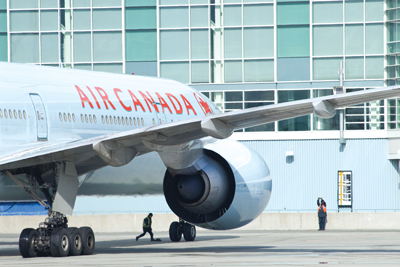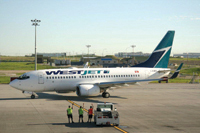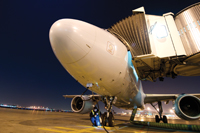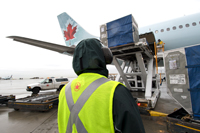
Features
Safety
Ensuring Continuous Improvement
Quality. An inescapable part of the aviation vocabulary but often misunderstood.
April 14, 2010 By David Olsen
Quality. An inescapable part of the aviation vocabulary but often misunderstood. Canadian Aviation Regulation (CAR) 107 links quality assurance (QA) with safety management (SMS) and, unfortunately, QA and SMS are sometimes described as being the same; but they are not, and Standards documents make no such claim. QA is one part of a quality management system (QMS) which the International Standards Organization (ISO) defines as quality policy, objectives, planning, control, assurance and improvement.
 |
| Air Canada’s move to its current corporate quality system was achieved with company-wide standardization and co-operation.
PHOTO: Brian McNair
|
The links between SM and QA are easily blurred and Transport Canada (TC) believes misunderstandings arose because some certificate holders did not understand the human and organizational factors addressed by SMS, thinking that a QA program met the SMS requirements.
Are the ISO 9000 quality standards dreamed up by bureaucrats in Geneva just to annoy us? Think again. Quality management is very much a Canadian initiative and Canada plays a major role in the development of ISO 9000 standards. The first ISO quality standards were based on those developed concurrently by the U.K. and the Canadian Standards Association (CSA) giving Canadian companies and exports a competitive edge.
 |
| Operational and system quality assurance play an important role in the success of WestJet’s SMS.
photos: WestJet
|
CARs require that some air operators, maintenance organizations (AMOs), airports, air navigation services (ANS) and flight training units have a quality assurance program covering virtually all operations and maintenance activities. QA is part of the QM concept of getting it right – the first time. QA means operations, maintenance and the SMS are done right and subject to continuous scrutiny and improvement.
Do CARs define QA? No – but ISO and the American Society for Quality (ASQ) do. QA focuses on providing confidence that quality requirements will be fulfilled – leading to the question – what are they? Quality requirements are what the customers need or expect – in the case of Transport Canada and regulators, an expectation that is obligatory. Certificate holders are obliged to meet the requirements of the certificate and must do everything possible to provide confidence that they do – i.e., quality assurance. Don’t just say you run a safe airline or airport and your SMS works – show your training records, procedures, ramp accident records, risk assessments, checklists and your audit results.
The core of quality programs is designing things right, doing it right, documenting it clearly, proving that you do it right, and continuously improving it – in order to ensure customer satisfaction. Another quality mantra encapsulates what QA is about: “Say what you do, do what you say, prove it, and improve it.”
CARs do not require QA to address passenger complaints, although disgruntled airline passengers may wish that they did. However, air operators have a direct financial relationship with the travelling public, whereas ANS providers, AMOs and even airports may not. Thus, aviation quality systems have evolved primarily to ensure operational and maintenance services make an uncompromising contribution to safety, rather than passenger comfort. Nevertheless, mention “quality” to passengers and they will link it to their personal experience with airlines and airports. If check-in or security queues are long, or there is a technical delay, passengers may feel they have had a poor quality experience – even though the operational QA program of the airport or airline contributes to safe travel. Just as absence of accidents does not imply safety or absence of risk (might just be good luck), passenger inconvenience may not imply absence of operational quality assurance. There is another deadly business trap – absence of complaints does not imply high customer satisfaction – the customer may just feel you don’t care, so your load factors go down while your competitor’s go up.
The IATA Operational Safety Audit (IOSA) program is a major force in aviation quality management and safety. All member airlines are committed to being audited by IOSA which “is a standardized audit program supported by a rigorous quality assurance process.” It can’t get much clearer than that.
Alarming media reports about the regulation of safety management, and implicitly the QA programs to underpin it, were quoted by Rose Simpson in the Canada Safety Council’s Fall 2009 magazine. Comments ranged from Virgil Moshansky (the Dryden Inquiry), “I think it’s scandalous that the government has abdicated its responsibilities to ensure the safety of its citizens,” to Kirsten Brazier who said operators will try to cut corners when the regulator is not looking and that “there’s a kind of recklessness when people fly.” All the ingredients for public outrage, but as John David, Nav Canada’s vice president, Safety and Quality pointed out, “SMS is an ICAO program, agreed to by States and organizations worldwide.”
So why the hullabaloo in Canada about CARs requirements for SMS and QA? Perhaps it is presentation style or the increasing politicization of government departments such as Transport Canada. Politicians find it expedient to attack “big government” and call for tax cuts and dismantling of “bureaucratic structures.” In plain English (instead of politico-speak), that might seem to undermine the very institutions and structures that keep the travelling public safe. Thus, there is public suspicion that initiatives such as aviation SMS are merely political schemes to save money for electioneering tax cuts and make the industry self-regulating.
TC responds that SMS and QA are not self-regulation and companies are subject to on-going surveillance with enforcement action as necessary. Spokeswoman Maryse Durette explains that TC inspectors previously concentrated efforts on physical inspections to determine if a company met regulations. Now, CARs enable inspectors to identify safety issues and measure how effectively the regulations are implemented and SMS is working. In addition, a proposed amendment to CARs will mandate QA for all air operators.
Let’s look at the facts. SMS and QA imply self-monitoring of compliance with CARs so we can get it right before the inspector calls. Canada’s key aviation players, such as airlines, manufacturers, NAV CANADA and major maintenance organizations have had quality and safety management systems in place for years as good business practice. NAV CANADA, with an enviable safety record, has had systems in place since 1997, and under a formal integrated safety management working group, these are reviewed and enhanced every year. Air Canada is IOSA certified every two years and completed its full TC SMS implementation in 2008.

|
 |
| Top: Air Canada ground crew checking tires on A319. Bottom: NAV CANADA says QMS and SMS are vital to the unforgiving safety-critical task of managing Canadian and international airspace. Photo shows ADS-B&PAL shelter tower, Saglek, Labrador.
PHOTO (top): Air canada (bottom): Nav canada
|
NAV CANADA and Air Canada are adamant that self-regulation has no place in civil aviation. That doesn’t mean QA and SMS is easy and Natasha Kowalchuk, Manager Corporate Quality Services at Air Canada describes moving the previous Air Canada “silo oriented” quality management systems to the current laterally-based corporate quality system, as “a long road.” “But it has been done,” she says, “with company wide standardization and co-operation – and it works.” Key components are quality, safety, and audit training, plus commitment, with staff trained to CSA, ISO and IATA standards as appropriate. Kowalchuk describes her experience as an investment in her by Air Canada, working in Customer Relations, In-Flight Service and Safety, Health and Safety, and training with CSA, and IATA. Now, as Manager Corporate Quality Services leading the IOSA re-certification and internal and external audit teams, Kowalchuk affirms “there is no easy ride from Transport – they come in and say, show us; and they look minutely.” As for the priority of safety – “it’s a line you cannot cross in Air Canada – no matter how tough the economy.”
NAV CANADA’s John David stresses that QMS and SMS are vital to the unforgiving safety-critical task of managing Canadian and international airspace. The Tech/Ops, Engineering and Environmental groups already meet the ISO 9001 and 14000 standards, while NAV CANADA fully supports the CARs SMS and QA requirements.
WestJet based its Flight Operations quality management program on the AS9100 quality standard as part of the SMS. Although not currently seeking ISO registration, Mike Plottel, Director Safety Services says that the AS9100 aerospace Standard provides a solid foundation for WestJet’s expanding operations and complex operating environment.
“Operational and system quality assurance play an important role in the success of WestJet’s SMS,” says Plottel, “enabling integration of elements throughout the organization and, ultimately, being most effective in managing operational risk.” The SMS QA component is seen to increase visibility and accountability for safety at Executive and Board levels, driving effective operational risk management programs and ensuring that all stakeholders are engaged in the “Plan-Do-Check-Act” cycle of continuous improvement.
The Canadian Airports Council (CAC) SMS Best Practices Working Group identifies, and standardizes the best safety and quality practices of member airports. “A program that works,” says Steve Burchi, Regina International Airport VP Operations, although CAC considers that the SMS regulatory requirements have placed an additional financial burden on airports through the increased staff and training needs.
 |
| As for the priority of safety, Air Canada says it’s a line you cannot cross, no matter how tough the economy.
PHOTO: air canada
|
Nevertheless, airports are committed and Regina International Airport is a classic example of doing it right. In 2008 Steve Burchi took the airport through the SMS roll-out, setting up an integrated team of SMS/QA consultants and airport personnel headed by Airport Safety Manager Kevin Hembroff. The team laid a solid SMS foundation and the consultants also provided CARs-compliant HF and SMS training. Hembroff has prime responsibility for implementing all phases of the SMS and “keeping it on the front burner.”
This paid dividends, with Burchi able to complete most Phase 2 requirements well ahead of the March 31, 2010 deadline. He asserts it involves major culture change and different ways of managing and measuring performance but “it makes no sense to go through the transition without the QA discipline of measuring how well we are doing.” Burchi believes firmly in the QM concept of continuous improvement as the cornerstone of SMS. “QA is not easy,” he says “but nor is it difficult or complex – what it needs is discipline and focus to stay the course.” He will implement a QA program well before the CARs deadline, helped by early progress on SMS Phases 2 & 3.
Burchi accepts that it will take time and resources – “that’s the reality of moving forward.” His key concern – “we don’t want a paper exercise or just check boxes on a form. We need to demonstrate the real value in what we are doing and prove it to whoever asks.” As he puts it, “QA is the string that ties the SMS and safe airport operations package together; it enables measurement of progress and continuous improvement.”
In B.C., Campbell River Airport demonstrates how smaller operators can implement QA and SMS if management is resolute. Airport manager Tyler Massee has led his airport and consultant team through Phases 1 and 2 and has already completed the safety, HF and QA training and SMS manual.
Finally, we can do no better than heed the words of leading quality expert Gary Grass, Quality/SMS Manager at prestigious charter operator Blackcomb Aviation:
Those who take the time and effort to develop, embrace and mature an integrated SMS, have consciously chosen to walk the path toward aviation excellence and establish a means by which they differentiate their business model from one of commonplace and mediocrity. The cornerstone of an effective SMS is Quality Assurance.